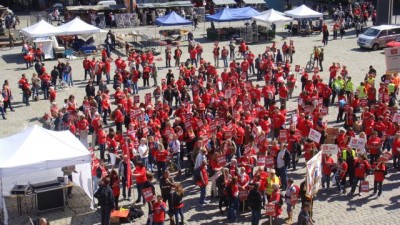As striking public sector workers rallied in the Norwegian capital and elsewhere around the country, many of them were anything but pleased with a settlement involving thousands of colleagues in Oslo. Labour organizations LO and Akademikerne accepted an offer other unions have rejected, and a strike by two other union confederations, Unio and YS, continued on Thursday.

There were some initial signs of hope that the deal struck between Oslo city officials, LO and Adademikerne on Wednesday would clear the way for a settlement with other unions after their strike had spread to Oslo. LO and Akademikerne, which represents highly educated workers such as public sector lawyers, accepted an offer that gives them a pay raise of 3.96 percent and which can be raised further if other striking unions win more.
By Thursday morning, however, it was clear that the settlement in Oslo mostly irritated the union groups YS and Unio and they vowed to carry on their strike action. It was already closing down schools and day care centers in Oslo on Thursday, and even halting garbage collection.
Some union leaders seemed furious that LO and Akademikerne had accepted Oslo’s offer. “This only means that for one strange reason or another, they accept a result which is so poor that folks are striking in all the other municipalities and in the state,” Anders Folkestad, leader of Unio, told newspaper Aftenposten.
There were a few local unions in Oslo with ties to LO that rejected the settlement and added more than 90 of their members to the roughly 700 workers now on strike in Oslo, but the vast majority went along. That disappointed Tore Eugene Kvalheim, head of YS, who feared Oslo’s acceptance would “infect” the rest of the municipalities in Norway.
That’s exactly what many others hope will happen, as the biggest national strike in nearly 30 years dragged into its seventh day. State officials, led by Prime Minister Jens Stoltenberg of the Labour Party, were holding firm as of Thursday, claiming their own offer of a 3.75 percent pay hike was good.
Public pay hikes lower than private sector’s
At a time when workers in many other countries are losing their jobs or seeing their pay and benefits cut, Stoltenberg has support for his stand, not least among business leaders keen on keeping labour costs in Norway down. They fear that Norway’s wage and benefit costs will get so high that their competitive position internationally, already strained, will deteriorate further.
Some economists, however, have pointed out that the striking labour unions’ are correct in claiming that their members’ pay development hasn’t been as good in the public sector as it has been in the private sector. Wage hikes set by government officials, also those before Stoltenberg’s left-center government assumed power in 2005, have lagged actual pay raises in Norway nine times over the past 12 years.
Stoltenberg’s government has understated pay development every year for the past six years. Last year, for example, the finance ministry expected pay levels to increase by 3.9 percent, reported Aftenposten, when they in fact rose 4.2 percent. The difference was greater in 2010, when the government set pay hikes at 3.25 percent, when they ended up rising by 3.7 percent overall in Norway.
“We have looked at what the pay settlements yielded in the private sector and see a similar trend this year,” Harald Magnus Andreassen, chief economist at First Security in Oslo, told newspaper Dagsavisen. “It’s a number over 4 percent, that’s not unreasonable.”
That suggests the unions’ demands for at least 4 percent isn’t unreasonable either. Andreassen, however, stressed that pension benefits in the private sector are far less secure than in the public sector. Job security in general is better in the public sector than the private sector, suggest others, and Andreassen doesn’t think pay levels in the public and private sectors should be the same.
With both sides remaining far apart, several professors and economists think something called tvungen lønnsnemd (compulsory arbitration) will eventually be ordered if the strike is viewed as threatening liv og helse (life and health). It may be just a matter of time, as health care services are cut back and garbage piles up.
Views and News from Norway/Nina Berglund
Please support our stories. Readers in Norway can use our donor account. Our international readers can click on our “Donate” button:

